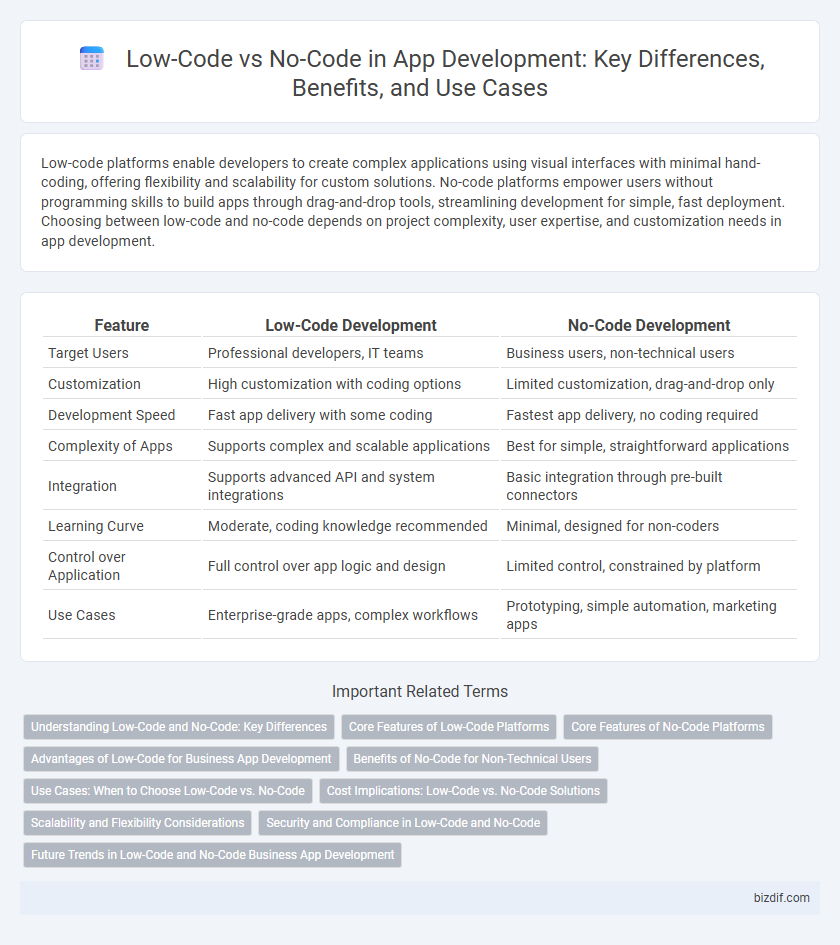Low-code platforms enable developers to create complex applications using visual interfaces with minimal hand-coding, offering flexibility and scalability for custom solutions. No-code platforms empower users without programming skills to build apps through drag-and-drop tools, streamlining development for simple, fast deployment. Choosing between low-code and no-code depends on project complexity, user expertise, and customization needs in app development.
Table of Comparison
| Feature | Low-Code Development | No-Code Development |
|---|---|---|
| Target Users | Professional developers, IT teams | Business users, non-technical users |
| Customization | High customization with coding options | Limited customization, drag-and-drop only |
| Development Speed | Fast app delivery with some coding | Fastest app delivery, no coding required |
| Complexity of Apps | Supports complex and scalable applications | Best for simple, straightforward applications |
| Integration | Supports advanced API and system integrations | Basic integration through pre-built connectors |
| Learning Curve | Moderate, coding knowledge recommended | Minimal, designed for non-coders |
| Control over Application | Full control over app logic and design | Limited control, constrained by platform |
| Use Cases | Enterprise-grade apps, complex workflows | Prototyping, simple automation, marketing apps |
Understanding Low-Code and No-Code: Key Differences
Low-code platforms require some level of coding knowledge, enabling developers to customize applications with pre-built components and drag-and-drop interfaces, which accelerates the development process. No-code platforms target non-technical users by providing completely visual tools that eliminate the need for coding, focusing on ease of use and rapid deployment. Understanding the key differences between low-code and no-code solutions helps organizations choose the best approach based on their technical expertise, project complexity, and customization needs.
Core Features of Low-Code Platforms
Low-code platforms offer visual development tools, reusable components, and integration capabilities that accelerate app creation while allowing custom coding for complex requirements. These platforms provide enhanced scalability, security controls, and role-based access to support enterprise-grade applications. Core features include drag-and-drop interfaces, API connectors, automated workflows, and version control for collaborative development.
Core Features of No-Code Platforms
No-code platforms enable app development through visual interfaces and drag-and-drop functionality, eliminating the need for programming knowledge. Core features include pre-built templates, customizable workflows, and seamless integration with third-party APIs, enhancing rapid prototyping and deployment. These platforms prioritize user accessibility, empowering business users to create functional applications without technical barriers.
Advantages of Low-Code for Business App Development
Low-code platforms enable businesses to accelerate app development by providing customizable templates and pre-built components that reduce coding effort while allowing complex integrations and scalability. These platforms support IT teams and professional developers in creating robust, secure applications tailored to specific business processes, ensuring higher flexibility and control compared to no-code solutions. Low-code enhances collaboration between technical and non-technical stakeholders, improving innovation speed and reducing time-to-market for enterprise-grade applications.
Benefits of No-Code for Non-Technical Users
No-code platforms empower non-technical users to create functional applications through intuitive drag-and-drop interfaces, eliminating the need for complex programming knowledge. These tools significantly reduce development time and costs by streamlining workflows and enabling rapid prototyping. Enhanced accessibility promotes innovation across business units, allowing teams to address unique challenges without the reliance on specialized developers.
Use Cases: When to Choose Low-Code vs. No-Code
Low-code platforms are ideal for organizations requiring custom integrations, complex workflows, or scalable applications that involve professional developers and IT teams. No-code solutions suit business users needing to build simple apps, automate tasks, or create prototypes quickly without coding knowledge. Choosing between low-code and no-code depends on project complexity, development speed, and the level of technical expertise available.
Cost Implications: Low-Code vs. No-Code Solutions
Low-code platforms typically require some level of developer expertise, resulting in higher initial costs compared to no-code solutions, which enable business users to build apps without programming skills. No-code platforms reduce expenses related to hiring specialized developers and shorten development cycles, making them more cost-effective for simple applications. However, low-code solutions offer greater flexibility and scalability, which can lower long-term costs for complex projects by minimizing the need for extensive rework or third-party integrations.
Scalability and Flexibility Considerations
Low-code platforms offer greater scalability and flexibility for app development by allowing deeper customization through coding, making them suitable for complex enterprise solutions that require integration with existing systems. No-code platforms, while beneficial for rapid prototyping and simpler applications, often face limitations in scalability and customization due to pre-built templates and restricted functionality. Choosing the right platform involves assessing long-term project needs, including potential growth, integration demands, and the availability of development resources.
Security and Compliance in Low-Code and No-Code
Low-code platforms offer enhanced security features and compliance controls by enabling developers to implement custom code and integrate security protocols tailored to enterprise requirements. No-code platforms prioritize ease of use but often rely on predefined templates and limited customization, which can pose challenges for meeting stringent security standards and regulatory compliance. Organizations must evaluate platform capabilities regarding data encryption, access controls, and audit trails to ensure robust security in app development.
Future Trends in Low-Code and No-Code Business App Development
Future trends in low-code and no-code business app development emphasize increased integration of artificial intelligence and machine learning to automate workflows and enhance user experiences. Enterprises are adopting hybrid platforms that combine low-code customization with no-code simplicity, accelerating digital transformation and reducing reliance on specialized developers. Security enhancements and scalable architecture in these platforms are driving widespread adoption across industries, enabling rapid, compliant, and agile app deployment.
Low-Code vs No-Code Infographic

 bizdif.com
bizdif.com